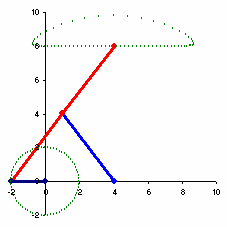Newton's law of motion
When Newton first published these laws back in the seventeenth century he caused a great deal of controversy. Even the top scientists and mathematicians of the day found difficulty in understanding what he was getting at and hardly anyone could follow his reasoning. Today we have little difficulty with the topic because we are familiar with concepts such as gravity and acceleration from watching astronauts floating around in space or satellites orbiting the earth. We can even experience them for ourselves directly on the roller coaster rides at amusement parks.
Newton lived in the second half of the seventeenth century and was born into a well-to-do family in Lincolnshire. He proved to be a genius at a very early age and was appointed to a Professorship at Cambridge University at the remarkably young age of 21. He spent his time investigating such things as astronomy, optics and heat, but the thing for which he is best remembered is his work on gravity and the laws of motion. For this he not only had to carry out an experimental study of forces but also he had to invent the subject of calculus.
According to legend Newton came up with the concept of gravity by studying a falling apple. The legend goes something like this. While Newton was working in Cambridge, England became afflicted by the Great Plague, particularly in London. Fearing that this would soon spread to other cities in the hot summer weather, Newton decided to head back to the family’s country estate where he soon found that there was little to do. As a result he spent a great deal of time sitting under a Bramley apple tree in the garden. He started to ponder why the apples were hanging downwards and why they eventually all fell to earth, speeding up as they fell. When one of the apples suddenly fell off and hit him on the head he had a flash of inspiration and realized that it was all to do with forces.
There is some truth in the legend and certainly by the time it was safe for him to return to Cambridge he had formulated the basis of his masterwork. After many years of subsequent work Newton was eventually able to publish his ideas in a finished form. Basically he
stated that:
Newton lived in the second half of the seventeenth century and was born into a well-to-do family in Lincolnshire. He proved to be a genius at a very early age and was appointed to a Professorship at Cambridge University at the remarkably young age of 21. He spent his time investigating such things as astronomy, optics and heat, but the thing for which he is best remembered is his work on gravity and the laws of motion. For this he not only had to carry out an experimental study of forces but also he had to invent the subject of calculus.
According to legend Newton came up with the concept of gravity by studying a falling apple. The legend goes something like this. While Newton was working in Cambridge, England became afflicted by the Great Plague, particularly in London. Fearing that this would soon spread to other cities in the hot summer weather, Newton decided to head back to the family’s country estate where he soon found that there was little to do. As a result he spent a great deal of time sitting under a Bramley apple tree in the garden. He started to ponder why the apples were hanging downwards and why they eventually all fell to earth, speeding up as they fell. When one of the apples suddenly fell off and hit him on the head he had a flash of inspiration and realized that it was all to do with forces.
There is some truth in the legend and certainly by the time it was safe for him to return to Cambridge he had formulated the basis of his masterwork. After many years of subsequent work Newton was eventually able to publish his ideas in a finished form. Basically he
stated that:
- Bodies will stay at rest or in steady motion unless acted upon by a resultant force.
- A resultant force will make a body accelerate in the direction of the force.
- Every action due to a force produces an equal and opposite reaction.




Comments